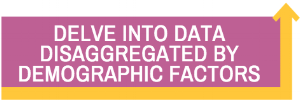Kindergarten Readiness
Raise DC's high-level goal: Every child is prepared for kindergarten.
We aim to increase the percentage of youth who enter kindergarten ready to learn.
Click on the buttons below or scroll down to dig into the citywide data on the indicators Raise DC tracks related to kindergarten readiness, as well as Raise DC's programmatic work toward this goal.
We recommend viewing the following data on a desktop or laptop to fully explore an interactive version of the indicators disaggregated by a number of demographics. Click here for a static version of the data.
Core Indicator: 4-Year-olds ON TRACK
Early DEVELOPMENT INSTRUMENT: On Track in all developmental domains
Early experiences shape young children’s development from the prenatal period until they enter kindergarten. During this extensive period of growth for the neural network in young children's brains, environmental conditions can create lasting effects on health and educational outcomes over the course of a lifetime. As innate learners, children are born with the capacity to succeed. Their environment, quality of relationships with adults, and experiences – all shaped by systems – can have an effect on whether they do thrive. Kindergarten readiness is a critical milestone that can shape success through school and into adulthood.
For the first time, a citywide indicator exists to examine the proportion of the District of Columbia's children who are ready for kindergarten. Using the Early Development Instrument's 2016 measure of 4-year-old children who are considered on track in all of its developmental domains as a baseline, DC's results provide an important look at the way environmental factors have influenced the outcomes of DC's young children.
UNDERSTANDING THE EARLY DEVELOPMENT INSTRUMENT (EDI)
The Early Development Instrument (EDI) is an internationally recognized tool that provides a citywide snapshot of young children's health, development, and school readiness by looking at its holistic domains. The EDI captures a moment in time for the District’s children – halfway between those at the start of life and 3rd graders’ academic achievement. Since the EDI is not an individual screening tool or evaluation, it can be used as a snapshot for the full population of children across the District.
DC’s EDI data was collected by the Office of the State Superintendent of Education (OSSE) in 2016 from pre-kindergarten teachers with 4-year-old students (referred to as pre-K 4) in DC Public Schools, public charter schools, and community-based organizations across the city. This baseline measure of the EDI allows us to observe citywide strengths and inequities. While this page contains citywide-level data, outcomes are also mapped to where children live, giving residents a sense of place by showing neighborhood-level results. (To view outcomes by neighborhood cluster maps, click here.) For more information about the Early Development Instrument, visit Our Children, Our Community, Our Change.
EDI DOMAINS
The EDI focuses on five domains that look not only at academic success, but also on the social and emotional development children need to thrive and be ready for school. These domains include:
For more information about the EDI domains and the subdomains contained within each, visit Our Children, Our Community, Our Change.
ON TRACK IN ALL DOMAINS
Raise DC's core indicator of its citywide goal of kindergarten readiness – the percentage of 4-year-olds on track in all domains (as measured by the EDI) – provides a baseline insight for how our young children are faring developmentally.
CORE INDICATOR
In DC, approximately one-third of 4-year-old children are considered on track in all EDI domains. This baseline provides first-time data of where DC’s pre-K 4 children are developmentally, as well as a place for the District to begin tracking change over time.
The terms "on track", "at risk", and "vulnerable" are part of agreed-upon language used as part of a nationally normed distribution scale. "Vulnerable" indicates that children are vulnerable for problems in later childhood. "At risk" indicates that children are at risk of becoming vulnerable without the right supports. "On track" children are meeting developmental milestones for this age group. Please note that the EDI's at-risk definition is a context-specific term that differs from that of the DC education community. Visit the Data Dictionary for additional details about this term in context. For more on the EDI terminology and cutoffs, check out the section, "How is vulnerability calculated?"
DATA DISAGGREGATED BY DEMOGRAPHIC SUBGROUPS
Raise DC disaggregates data on our core indicator by key demographic factors in order to shine a light on where we can best make progress toward our high-level goal of kindergarten readiness. Disaggregating data means breaking down information into smaller sub-populations, such as race/ethnicity, sex, and other demographic factors. Identifying where differences exist is an important step to understanding and addressing inequities in our community. Below, you'll find:
A breakdown of the EDI outcomes by race/ethnicity and by important demographic factors
A disaggregation of the proportion of children on track, at risk, and vulnerable by race/ethnicity
A focus on the percentage of children who are on track in all, some, or none of five domains
After exploring the following data, if additional data disaggregation or analysis may be helpful, reach out to ourchildren@raisedc.org.
EXPLORE THE DATA
OUTCOMES BY RACE/ETHNICITY & DEMOGRAPHIC FACTORS
When the EDI outcomes are disaggregated citywide by race/ethnicity, we see that a greater proportion of multiracial, White, and Asian/Asian American children are considered on track than their African American/Black and Hispanic/Latinx counterparts. Additionally, young males are more at risk or vulnerable than their female counterparts in all race/ethnicity groups.
In considering demographic factors that may influence DC children's ability to thrive, our pre-K 4 students who have an Individual Education Plan (IEP) have the highest proportion who are vulnerable in one more domains (63%) versus students without an IEP (24%).
DOMAIN-FOCUSED OUTCOMES BY RACE/ETHNICITY
Reviewing the EDI outcomes individually in each of the five domains shows the majority of pre-K 4 children, regardless of race/ethnicity, are considered on track. Social competence is a domain where all subgroups of students show low proportion of vulnerability and high proportion of children on track.
As measured by the EDI, DC’s children demonstrate a lower proportion of children on track in the language and cognitive development domain. This domain includes a subdomain – advanced literacy – with items such as “able to read simple sentences” or “able to write simple sentences” that more closely align with Common Core Kindergarten Standards than DC’s Early Learning Standards. In DC, thanks to universal pre-K, the EDI measures children in pre-K 4, while most of the United States collects data from kindergarten students. Please keep this nuance in mind when interpreting and acting on this domain’s outcomes. For more information or to explore information about the subdomains, visit the Our Children, Our Community, Our Change site.
ON TRACK IN ZERO - FIVE DOMAINS
As we know from Raise DC's core indicator – on track in all domains – approximately one-third of DC's pre-K 4 children are considered on track. When coupled with the percentage of children on track in four domains, this portion of children encompasses nearly two-thirds of DC's pre-K 4 children.
ACTING ON THE DATA
Armed with a baseline measure of how DC's 4-year-olds are faring in the EDI's developmental domains (33% considered on track in all domains) and an understanding of some of the demographic factors that further illuminate it, Raise DC's early childhood work provides opportunities to act on the data. Learn more about Our Children, Our Community, Our Change below, and explore available resources to use the EDI to effect change. Have ideas on other ways to use this data for action? Reach out to Raise DC at ourchildren@raisedc.org.
OUR WORK
In partnership with the Office of the State Superintendent of Education (OSSE), Raise DC is focusing its early childhood efforts on a community engagement initiative to encourage use of the Early Development Instrument outcomes among stakeholders throughout DC. Our Children, Our Community, Our Change launched in spring 2017, and its online hub, located at raisedc.org/ourchildren, contains numerous resources, including:
In 2018, Raise DC is supporting OSSE as it recruits schools and centers across the District to generate the next wave of EDI data. The 2019 data will allow the city to examine how the early childhood education system is supporting thriving children – both overall and in different neighborhoods and subgroups from this baseline indicator. This will allow us to assess progress and continued opportunities for action.
Spotlight: MARTHA'S TABLE
For more than 35 years, Martha’s Table has provided DC children and families with vital resources. As it expands into Ward 8 in 2018, the organization remains focused on supporting stronger children, stronger families, and stronger communities in Washington, DC, by increasing access to quality education programs, healthy food, and family supports and is using the EDI as a tool to bolster that work.
Martha’s Table is embedding the EDI into its birth-to-eight strategy and using the Our Children, Our Community, Our Change resources in several ways. The EDI is influencing the organization’s own child-center programming by identifying potential gaps in resources that contribute to positive outcomes for children. The partnership’s resources have also allowed Martha’s Table to facilitate conversations about the desired outcomes for kids and families across various organizations and sectors, including nutrition, education, health, and philanthropy.
Using the EDI maps, the organization has listened to stories and perspectives from community members and partners, including other child care leaders in Ward 8 and future families. Lastly, Our Children, Our Community, Our Change has allowed Martha’s Table to take a wider lens on the communities it serves and use the EDI as one measurement of the organization’s own impact in creating strong systems change over time.












